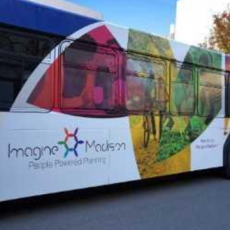






The Bus Stops here is produced monthly by members of the Madison Area Bus Advocates.
If you could wave a magic wand, what would Madison’s transportation system look like?
 Imagine Madison is an update of the city’s comprehensive plan, which includes an examination of the transit system. (Photo courtesy of City of Madison’s Planning Division.)
Imagine Madison is an update of the city’s comprehensive plan, which includes an examination of the transit system. (Photo courtesy of City of Madison’s Planning Division.)
Working quietly and unseen in the background of our transportation system, removed from the day to day business of actual operations is a team of people who are creating a vision of the Madison they want to see, not what it is now. Fare free? Electric buses? A local and streamlined rapid system? A regional system? Those ideas may not garner headlines at the moment, but that does not mean that the vision may not have a powerful effect on what the future will look like.
Madison is in the process of updating its general Comprehensive Plan in a project called Imagine Madison. That plan is supposed to “drive decision-making and investment toward a healthier, more equitable and sustainable city” with a time horizon of perhaps 20 years, updated every ten years or so.
Begun in late Fall of 2016, its first of four phases are over (“where are we headed?”), and the program is starting its second phase (“how will we get there?”). Transportation is one of its seven main topics, others being: housing; land use; economic development; agricultural, natural and cultural resources; utilities and community facilities; and intergovernmental cooperation.
The transportation component will be fleshed out by Madison’s Long Range Transportation Master Plan called “Madison in Motion.” After years in the making, that plan was recently formally adopted by the Common Council at the end of February 2017. The draft document is still being edited to include revisions, so a final document does not yet exist (the most recent documents being available here.)
Madison in Motion starts with a vision of course: The City envisions a future with improved walkability, bikability and transit availability, which provides residents a variety of options to meet their transportation needs (from the draft Executive Summary). This general vision is, in turn, elaborated somewhat by a set of goals or guiding principles:
Expand mobility choice (support a range of options for all user types.)
Improve safety and health (contribute to healthy living and quality of life for all residents.)
Attend to transportation equity (address the needs of all users.)
Enhance neighborhoods (Invest for strong, vibrant neighborhoods.)
Promote beneficial growth (environmentally and fiscally sustainable development)
Steward the environment (promote air and water quality)
Observe fiscal responsibility (should be affordable for current and future generations)
Foster economic development (projects should promote opportunity and prosperity)
You may laugh to read that Madison in Motion exhibited remarkable constraint by making only 27 recommendations for achieving those goals. Those recommendations were in turn considered short term (1-2 year) or medium term (3-5 years). The eighteen short term recommendations were:
Transit
Bus Rapid Transit (in accordance with all applicable local, state and federal regulations.)
Route Restructure (meant to improve system performance, but potentially quite problematic)
Install Transit Pass Vending Kiosks at transfer points, public buildings and undeserved areas to Expand Transit Pass Accessibility
Provide [unspecified] “first mile/last mile” solutions that would enhance convenience and service
Institute a regional transportation governance entity for urbanized area of Dane County
New Metro maintenance facility (funding application has been turned down twice now)
Transportation Demand Management (TDM)
Develop a Transportation Management Association (TMA) (to organize administration of TDM policies)
Incorporate workable TDM requirements in our zoning code
Bicycling
Improve winter bicycling (maintenance policies, biking routes, facilities plowing, etc.)
Implement Wayfinding System (consistent with bikeways throughout the county)
Map the current low-stress bicycle network (will help identify gaps)
Pedestrian
Identify high-need streets appropriate for sidewalk installation prior to street reconstruction
Land Use
Prepare Activity Center Plans (with priority for locations identified in Comprehensive Plan)
Integrate affordable housing in with transit at Activity Centers
Design BRT Corridor and Stations
Technology
Interdisciplinary team integrating transportation-oriented technologies with economic development
Incorporate rapidly evolving new transportation technologies (driverless vehicles etc.)
Evaluation
Performance Monitoring
Plans are notoriously bad in telling us what the future will in fact be, and are often shelved to gather dust as soon as they are “approved.” Proposed actions may require financing that does not materialize, political will that evaporates if it ever existed, or may threaten unintended side effects worse than the problem they set out to solve. Planning is still useful however. A recent post from the regional planning commission’s A Great Madison Vision said it well:
"Lack of perfect foresight, however, does not mean planning for the future is futile. Just the opposite, in fact. As Dwight Eisenhower once said, 'in preparing for battle I have always found that plans are useless, but planning is indispensable.' The better we can anticipate possible futures, the better we can prepare for and influence potential changes to achieve a desired future."
|
|
|
Welcome to the Madison Commons, a website designed to provide news and information about all of Madison's neighborhoods and a crossroads for the discussion of community issues. The name comes from the idea of a village commons, a place for news, talk, debate, and some entertainment, too, that's open to everyone.
All rights reserved. Read more about the Madison Commons and its partners.

